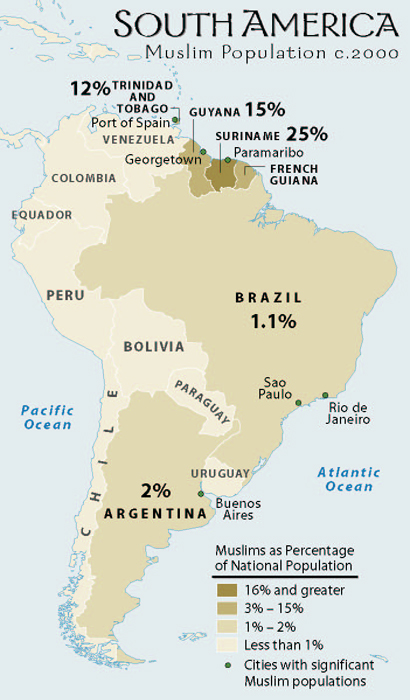HispanTV’s report on the King Fahd Mosque in Buenos Aires
The report notes that this is the place where a fusion of Islam and Latin America meet.
Iran has opened up a major televison propaganda network in the Spanish language called HispanTV. While the USA was ignoring South America, Saudi Arabia, and Iran were not.
Until the King Fahd Mosque opened, Islam was dying out in Argentina. It hovered officially between 1% and 2%, but in reality, an Argentine Acadmenic, Pedro Brieger, had shown that practicing Muslims in Argentina had whittled down to a small, and declining, number. Almost all Argentine Muslims had been non-practicing.
Source: Muslims in Argetina – Pedro Brieger
The number of Muslims in Argentina is decreasing, and this is due to several factors. Firstly, in families of Muslim origin, customs are being lost, from the Arabic language to food and drink. Secondly, there is relatively little reading material on Islam available in Spanish. There is a growing tendency toward mixed marriages in which children lose all references to Islam, and there are too few study centres for disseminating Islam. This may, however, change in the future with the construction of the new Islamic Cultural Center King Fahd, financed by the Saudi government, which includes a school and a mosque with a minaret in the heart of Buenos Aires.
But this successful effort at assimilating the Muslim immigrant came to an end around 2000.
In 1995, President Carlos Menem donated land in downton Buenos Aires so that the Saudis could build the King Fahd Mosque. Islam was given a chance to recharge itself.
Centuries of Christianizing efforts in Latin America were undone in one stroke. By 2011, the Saudi financed mosque had pressured Argentina’s Public TV to grant them an hour of public TV program time to prosyletize – weekly on Sunday mornings.
Worse yet, the time slot for the program was taken from a Christian-run secular TV show hosted by Christian Arab-Argentines, who were furious that a Muslim minority, who did not represent Argentine-Arabs, had stolen their time.
The damage is in its early stages, and it can be undone; but an attempt to undo the damage has to be made. No attempt seems forthcoming.
This is a disaster in slow motion.
We Americans have to show an interest in South America.

